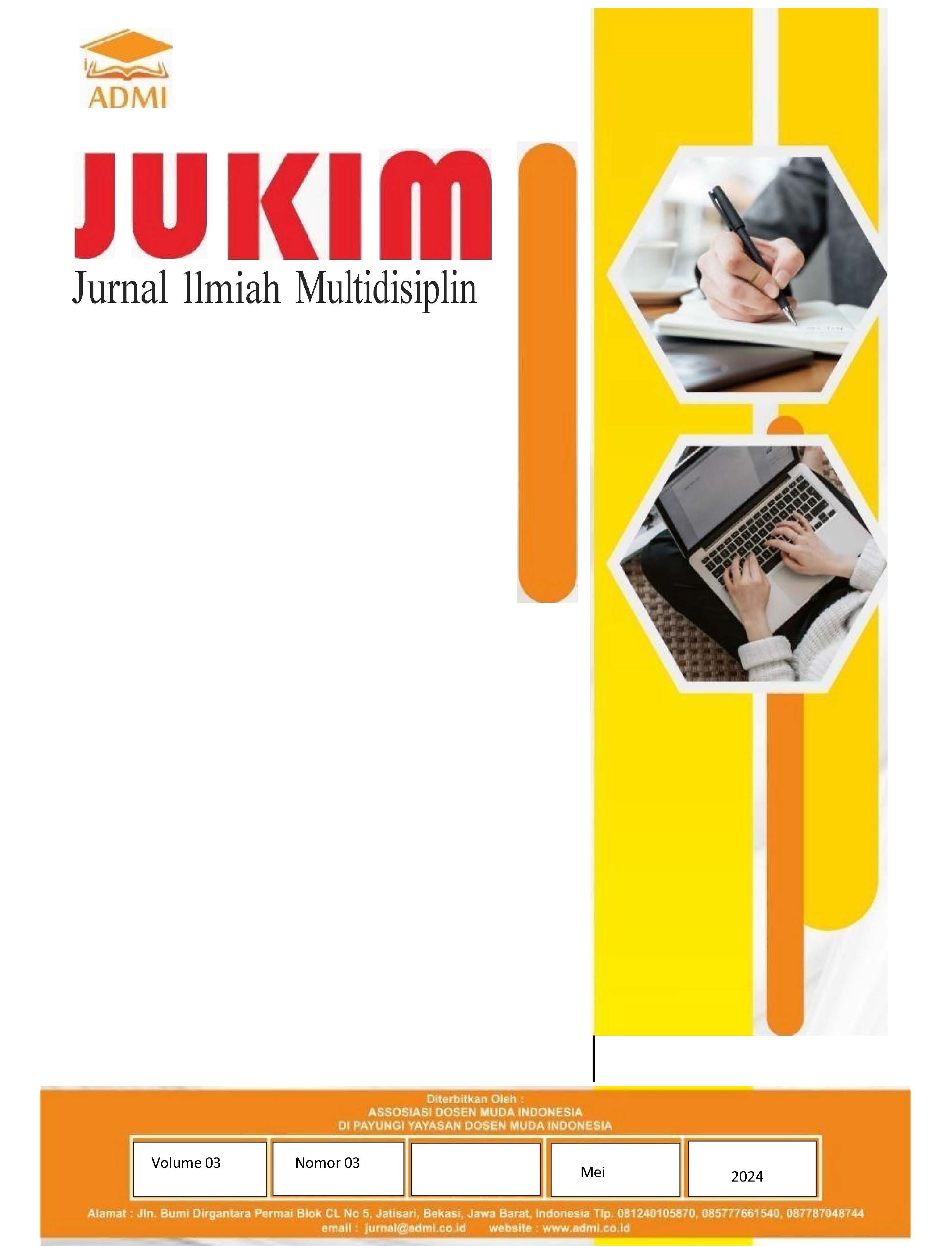Impact of Tansmigration Development UPT.Waleh SP.2 on Carbon Emissions
DOI:
https://doi.org/10.56127/jukim.v4i03.1977Keywords:
AGB, CO2, NDVI, NPP, TransmigrationAbstract
This article is the result of a research on the impact evaluation of transmigration development on carbon emissions in UPT Waleh SP.2, Central Halmahera Regency, North Maluku. Where the opening of transmigration land has the potential to change ecosystems, including vegetation cover, biomass, and greenhouse gas emissions, which can affect environmental sustainability. The objective of this study was to analyze changes in the ecosystem due to transmigration development, particularly on vegetation cover, carbon biomass, and carbon emissions. For this purpose, remote sensing technology and GIS-based spatial analysis were used with four main indicators: NDVI for vegetation cover, AGB for carbon biomass, CO as an emission indicator, and NPP for carbon absorption capacity. The results showed a decrease in NDVI, AGB, and NPP, as well as an increase in CO. Decreases in NDVI and AGB reflect vegetation degradation and biomass loss, while increases in CO are caused by human activities such as biomass burning and the use of motorized vehicles. The decrease in NPP indicates a decrease in the capacity of vegetation to absorb carbon.
References
[1] G. Galidaki et al., “Vegetation biomass estimation with remote sensing : focus on forest and other wooded land over the Mediterranean ecosystem,” Int. J. Remote Sens., vol. 38, no. 7, pp. 1940–1966, 2017, doi: 10.1080/01431161.2016.1266113.
[2] S. K. Pareta, K. C. Patra, R. Harwansh, M. Kumar, and K. P. Meena, “Protective effects of Boerhaavia diffusa against acetaminophen-induced nephrotoxicity in rats,” Pharmacologyonline, vol. 2, pp. 698–706, 2011.
[3] S. Madonsela, M. A. Cho, A. Ramoelo, O. Mutanga, and L. Naidoo, “Estimating tree species diversity in the savannah using NDVI and woody canopy cover,” Int. J. Appl. Earth Obs. Geoinf., vol. 66, no. December, pp. 106–115, 2018, doi: 10.1016/j.jag.2017.11.005.
[4] S. Arifin and R. Mardikaningsih, “Pencapaian Kepuasan Kerja Bagi Karyawan Melalui Kondusivitas Lingkungan Kerja Dan Motivasi Kerja,” J. Ilm. Satyagraha, vol. 5, no. 2, pp. 98–106, 2022, doi: 10.47532/jis.v5i2.476.
[5] K. D. Kanniah and H. C. Siong, “Urban forest cover change and sustainability of Malaysian cities,” Chem. Eng. Trans., vol. 56, pp. 673–678, 2017, doi: 10.3303/CET1756113.
[6] D. Indiarto and E. Sulistyawati, “Monitoring Net Primary Productivity dynamics in Java Island using MODIS satellite imagery,” 34th Asian Conf. Remote Sens. 2013, ACRS 2013, vol. 2, no. January, pp. 1730–1737, 2013.
[7] A. J. Wahyudi et al., “Carbon sequestration index as a determinant for climate change mitigation: Case study of Bintan Island,” IOP Conf. Ser. Earth Environ. Sci., vol. 118, no. 1, 2018, doi: 10.1088/1755-1315/118/1/012050.
[8] A. Rachdian and D. Yudi Setiawan, “Estimasi Cadangan Karbon Kelapa Sawit di Lanskap Sembilang Dangku, Sumatera Selatan,” Media Konserv., vol. 23, no. 2, pp. 153–161, 2018, [Online]. Available: https://media.neliti.com/media/publications/267641-the-estimation-of-oil-palm-carbon-stock-bd5f60cf.pdf
[9] U. N. E. Programme, “The relationship between biodiversity, carbon storage and the provision of other ecosystem services,” no. 2, pp. 1–109, 2014, doi: 10.1002/rem.21314.
[10] S. Adrati and Y. Augustine, “Pengaruh Volume Emisi Karbon, Pengungkapan Emisi Karbon, Pengungkapan Praktik Manajemen Emisi Karbon Terhadap Kinerja Perusahaan,” J. Kontemporer Akunt., vol. 2, no. 1, p. 32, 2022, doi: 10.24912/jka.v2i1.18123.
[11] F. Ascui and H. Lovell, “As frames collide: Making sense of carbon accounting,” Accounting, Audit. Account. J., vol. 24, no. 8, pp. 978–999, 2011, doi: 10.1108/09513571111184724.
[12] D. Handayani and A. Setiyadi, “Remote Sensing penginderaan Jauh,” Ed. Mei, vol. 7, no. 2, pp. 113–120, 2003.
[13] E. F. Lambin, H. J. Geist, and E. Lepers, “Dynamics of land-use and land-cover change in tropical regions,” Annu. Rev. Environ. Resour., vol. 28, no. January 2003, pp. 205–241, 2003, doi: 10.1146/annurev.energy.28.050302.105459.
[14] A. Angelsen and D. Kaimowitz, “Rethinking the causes of deforestation: Lessons from economic models,” World Bank Res. Obs., vol. 14, no. 1, pp. 73–98, 1999, doi: 10.1093/wbro/14.1.73.
15] F. Jafarova and A. Hajiyeva, “Food Security in State Programs of Azerbaijan (for Example of the Major Caucasus),” Econ. Soc. Dev. B. Proc., vol. 2–4, pp. 257–262, 2020, [Online]. Available: https://ezp.lib.cam.ac.uk/login?url=https://www.proquest.com/conference-papers-proceedings/food-security-state-programs-azerbaijan-example/docview/2423042843/se-2?accountid=9851%0Ahttps://libkey.io/libraries/603/openurl?genre=article&au=Jafarova%252C+Firuza%253
[16] J. Sharma and N. H. Ravindranath, “Applying IPCC 2014 framework for hazard-specific vulnerability assessment under climate change,” Environ. Res. Commun., vol. 1, no. 5, 2019, doi: 10.1088/2515-7620/ab24ed.
[17] R. A. Houghton, “Balancing the global carbon budget,” Annu. Rev. Earth Planet. Sci., vol. 35, no. May 2007, pp. 313–347, 2007, doi: 10.1146/annurev.earth.35.031306.140057.


















